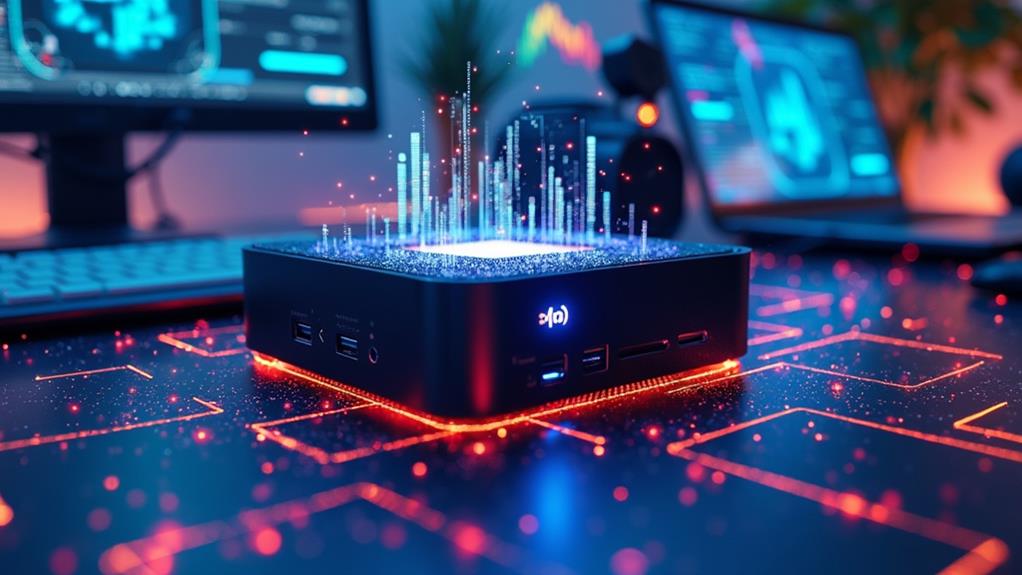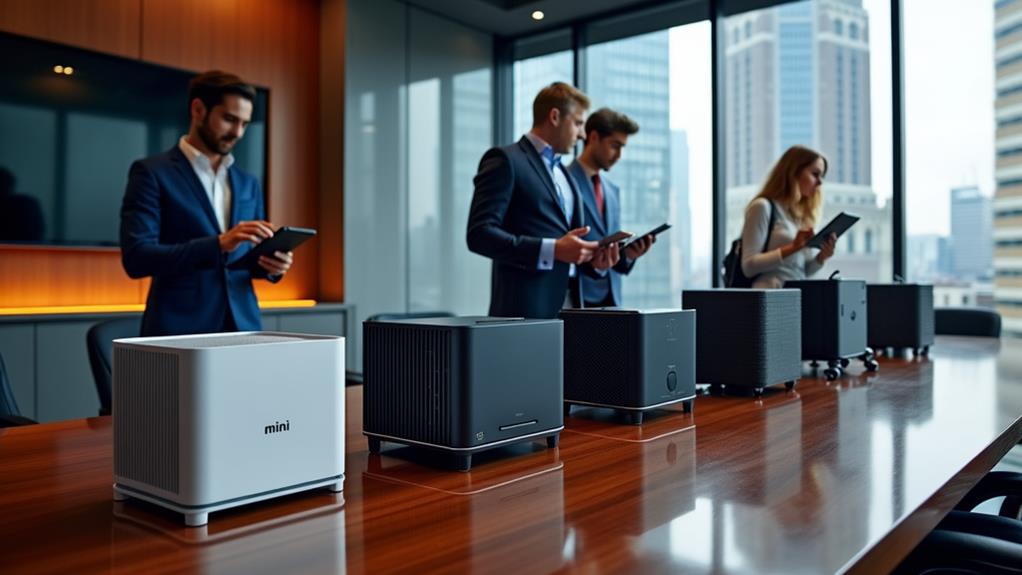



In the world of technology, the debate of mini-computers versus microcomputers has been a topic of discussion for quite some time. Both options offer compact and portable solutions for various computing needs. But the burning question remains: which one packs a more powerful punch? Are mini-computers really the superior choice? In this article, we will explore the differences between mini-computers and microcomputers, and shed light on their respective performance capabilities. So, sit back, relax, and let’s find out if a mini-computer truly holds the crown in the realm of computing power.
Understanding the Basics
Definition of a mini-computer
A mini-computer, also known as a midrange computer, is a type of computer that falls in between a mainframe and a microcomputer in terms of size, power, and cost. It is typically larger and more powerful than a microcomputer but smaller and less powerful than a mainframe. Mini-computers were popular in the 1960s and 1970s and were primarily used by businesses and research institutions for tasks such as data processing, scientific calculations, and simulations.
Definition of a microcomputer
A microcomputer, also commonly referred to as a personal computer (PC), is a small, affordable, and user-friendly computer designed for individual use. It consists of a microprocessor, memory, storage, and input/output devices, all integrated into a single electronic circuit board or chip. Microcomputers are widely used in homes, offices, schools, and various industries for tasks such as word processing, internet browsing, multimedia playback, and software development.
Brief history of both devices
The mini-computer emerged in the 1960s as a smaller and more affordable alternative to mainframe computers. Companies like DEC (Digital Equipment Corporation), IBM, and Hewlett-Packard played a significant role in the development and popularization of mini-computers. These machines were initially bulky and expensive, but they revolutionized computing by bringing powerful computing capabilities to medium-sized businesses and research institutions.
On the other hand, microcomputers gained traction in the 1970s with the introduction of the Altair 8800 and the subsequent release of pioneering microcomputers like the Apple II and IBM PC. These early microcomputers were limited in power and functionality but marked the beginning of a new era in personal computing. As technology advanced, microcomputers became increasingly powerful and versatile, eventually surpassing the capabilities of many mini-computers. Today, microcomputers dominate the consumer market, while mini-computers are still used in certain industries for specialized applications.
Comparing Processing Power
Determining factors of processing power
The processing power of a computer is primarily determined by its central processing unit (CPU). The CPU’s clock speed, number of cores, cache size, and architecture all play crucial roles in determining the computer’s overall processing power. Additionally, the efficiency of the CPU’s instruction set, memory bandwidth, and overall system architecture also contribute to the processing power of a computer.
Processing power of a mini-computer
Mini-computers are typically designed to handle more complex and demanding tasks compared to microcomputers. They often feature higher clock speeds, multiple high-performance processors, and larger cache sizes, allowing them to process large amounts of data at high speeds. Mini-computers are optimized for multi-threaded workloads and can efficiently handle simulations, scientific calculations, virtualization, and other resource-intensive tasks.
Processing power of a microcomputer
Microcomputers have come a long way in terms of processing power. Today’s microcomputers can rival, and in some cases, even surpass the processing power of older mini-computers. With advancements in CPU technology, microcomputers now boast high clock speeds, multi-core processors, and efficient instruction sets. While they may not match the raw processing power of high-end mini-computers, microcomputers are more than capable of handling everyday computing tasks, including multitasking, multimedia playback, and light gaming.

Analyzing Speed and Efficiency
Speeds of mini-computer versus microcomputer
When it comes to raw processing speed, mini-computers generally have the edge over microcomputers. With their higher clock speeds, larger cache sizes, and multi-core processors, mini-computers are designed to handle intensive computational workloads quickly. On the other hand, microcomputers have made great strides in recent years and can deliver impressive speeds for everyday tasks. While microcomputers may not match mini-computers in sheer speed, they offer sufficient processing power for most users’ needs.
Efficiency ratings across both devices
Efficiency ratings of computers can be measured in multiple ways, including performance per watt and overall power consumption. Mini-computers often prioritize raw power over energy efficiency, as they are designed for heavy-duty computations. This results in higher power consumption, which can be a concern for large-scale deployments. In contrast, microcomputers prioritize energy efficiency, aiming for the best performance per watt. Microcomputers are designed to be energy-efficient and are often favored for their low power consumption, making them suitable for personal use and small office environments.
Real-world applications and efficiency
The efficiency of a computer system can vary depending on the specific applications it is used for. In certain scenarios that require intensive calculations or large-scale data processing, mini-computers excel due to their high processing power. These applications include scientific research, financial modeling, complex simulations, and virtualization. On the other hand, microcomputers are highly efficient in everyday tasks such as web browsing, document editing, multimedia playback, and casual gaming. Their optimized power consumption allows for longer battery life in laptops and reduced electricity bills in desktop systems.
Storage and Memory Capabilities
Storage options in mini-computers
Mini-computers typically offer a wide range of storage options to accommodate diverse needs. These options can include traditional hard disk drives (HDDs), solid-state drives (SSDs), and even tape drives for long-term archival storage. Due to their intended use in enterprise and research environments, mini-computers often feature multiple drive bays, allowing for high storage capacities and data redundancy options. Additionally, mini-computers often support various storage interfaces such as SATA, SAS, and NVMe, allowing for high-speed data transfers.
Memory capacity in microcomputers
Microcomputers commonly feature a range of memory options, primarily based on the type of system and usage requirements. Typical microcomputers offer memory capacities ranging from a few gigabytes to several tens of gigabytes. This is sufficient for most users’ needs, including running multiple applications simultaneously, web browsing, and multimedia consumption. However, microcomputers may have limitations on memory expansion due to their compact designs and limited physical space.
Impact of storage and memory on overall performance
The storage and memory capabilities of a computer play a significant role in its overall performance. In mini-computers, the availability of ample storage options and large memory capacities allows for efficient handling of large datasets and enables faster data access. This is particularly advantageous for database-intensive applications, scientific simulations, and virtualized environments. In microcomputers, although storage and memory options may be more limited, they are generally sufficient for everyday tasks and casual gaming. However, intensive tasks involving large files or complex software may see performance improvements with upgraded storage and memory.

Exploring Software Compatibility
Compatible software with mini-computers
Mini-computers typically run on specialized operating systems and are optimized for running complex and demanding software applications. They often support a wide range of software, including proprietary software for scientific calculations, engineering simulations, and database management. Additionally, mini-computers can also run general-purpose operating systems such as Linux and Windows, allowing compatibility with a broad range of software available for these platforms.
Compatible software with microcomputers
Microcomputers are highly compatible with a vast array of software applications. They can run popular operating systems like Windows, macOS, and Linux, which support a wide range of software for various purposes. Microcomputers are capable of running productivity suites, graphic design software, video editing tools, media players, web browsers, and many other applications commonly used by individuals and businesses alike. Furthermore, the availability of mobile apps on microcomputers further expands the software compatibility and versatility of these devices.
Impact of software on performance
The performance of both mini-computers and microcomputers can be influenced by the software running on them. Optimized software designed for a specific type of computer can fully take advantage of its hardware capabilities, leading to enhanced performance. In the case of mini-computers, specialized software can leverage their processing power, memory, and storage capacities to deliver optimal performance for resource-intensive tasks. Microcomputers, being more widely used and accessible, benefit from a vast selection of software optimized for their hardware specifications, allowing users to accomplish a wide range of tasks efficiently.
Key Features and Specifications
Key features of mini-computers
Mini-computers are characterized by several key features that distinguish them from other types of computers. These features include high processing power, large memory and storage capacities, robust system architecture, multiple input/output ports, and advanced networking capabilities. Additionally, mini-computers often support features like virtualization, fault-tolerant hardware, and rapid data backup and recovery, making them suitable for critical operations in businesses and research institutions.
Key specifications of microcomputers
Microcomputers offer a wide range of key specifications that cater to individual user needs. These specifications include various form factors, such as tower, desktop, all-in-one, and compact systems, allowing users to choose the one that fits their workspace. Microcomputers also offer processors with different clock speeds and core counts, memory options, storage configurations, and connectivity ports. Display resolutions, graphics capabilities, and audio features also vary among different microcomputer models, enabling users to find the right combination of specifications that suit their requirements.
Comparing and contrasting both device’s features
When comparing the features of mini-computers and microcomputers, it becomes evident that they serve different purposes and target different user bases. Mini-computers prioritize power, scalability, and enterprise-level features, making them appropriate for resource-intensive tasks in professional environments. On the other hand, microcomputers prioritize versatility, affordability, and ease of use, making them suitable for personal and small-scale usage. While mini-computers offer robust features and extensive customization options, microcomputers excel in flexibility, consumer-oriented applications, and a wide variety of choices.

Energy Consumption and Efficiency
Energy usage of mini-computer
Mini-computers are known for their higher energy consumption compared to microcomputers. Due to their larger physical size and higher processing power, mini-computers often require more power to operate. This can result in higher electricity bills and increased cooling requirements, especially when deployed in large numbers. Advanced power management technologies, such as power capping and dynamic voltage and frequency scaling, are often employed to improve energy efficiency in mini-computers. However, it is worth noting that energy-efficiency may not be a primary concern for users requiring substantial computing power.
Energy usage of microcomputer
Microcomputers are designed with energy efficiency in mind. Their compact size, low-power components, and optimized system designs allow microcomputers to operate using relatively low amounts of power. This makes microcomputers more environmentally friendly and cost-effective from an energy consumption standpoint. Furthermore, advancements in hardware and software technology have led to improved power management features in microcomputers, enabling them to dynamically adjust their power usage based on workload demands. Low-power modes and efficient sleep states help reduce idle power consumption, particularly in laptops and other portable devices.
Comparing energy efficiencies
When comparing the energy efficiencies of mini-computers and microcomputers, it is clear that microcomputers hold an advantage. They are designed to operate within tight power constraints while delivering adequate performance for everyday tasks. Microcomputers prioritize energy-saving technologies, such as power-efficient components, low-power modes, and smart power management. Consequently, microcomputers not only reduce energy consumption but also emit less heat, requiring less cooling infrastructure. However, it is important to consider the trade-off between energy efficiency and processing power, as mini-computers’ higher energy consumption often correlates with their superior computational capabilities.
Assessing Cost Factors
Cost of buying and maintaining a mini-computer
Mini-computers are generally more expensive to purchase and maintain compared to microcomputers. The higher price tag of mini-computers reflects their advanced hardware components, specialized features, and enterprise-grade reliability. Moreover, mini-computers require dedicated IT staff to manage and maintain the systems and associated infrastructure, adding to the overall cost. However, mini-computers can provide significant cost savings in certain industries by running complex software efficiently and consolidating multiple tasks onto a single machine.
Cost of buying and maintaining a microcomputer
Microcomputers, being designed for personal use and small-scale business environments, are much more cost-effective than mini-computers. They offer a wide range of options at various price points, allowing users to choose a system within their budget. Maintenance costs for microcomputers are relatively lower as well, as they are generally easier to service and upgrade compared to their larger counterparts. Furthermore, the wide availability of affordable components and accessories in the consumer market contributes to the overall cost-effectiveness of microcomputers.
Evaluating cost-effectiveness
The decision between a mini-computer and a microcomputer ultimately depends on the specific requirements and budget of the user or organization. While mini-computers come with higher upfront costs and maintenance expenses, their superior processing power and specialized capabilities can lead to significant gains in productivity and efficiency for certain applications. On the other hand, microcomputers provide a cost-effective solution for general computing tasks and are more accessible to individual users and small businesses with limited budgets. Assessing the cost-effectiveness involves considering the anticipated workload, necessary features, scalability requirements, and available resources.
Looking at User Experience
Usability and ease of use in a mini-computer
Mini-computers are generally designed for professional and specialized use cases, which may require a certain level of technical expertise. Their user interfaces and software environments often prioritize functionality over simplicity. However, advancements in user interface design and compatibility with popular operating systems have led to improvements in the usability and ease of use of mini-computers. Still, the learning curve and usability may be higher for individuals less familiar with complex computing systems.
Usability and ease of use in a microcomputer
Microcomputers excel in usability and ease of use, aiming to provide a user-friendly experience for individuals with varying levels of technical knowledge. Microcomputers come with intuitive graphical user interfaces, easy-to-understand software, and a vast ecosystem of applications designed for effortless installation and usage. Additionally, the availability of comprehensive documentation, online resources, and user communities further contribute to the overall usability of microcomputers.
Importance of user experience in evaluating power
User experience plays a crucial role in evaluating the power of a computer system. While raw processing power and technical specifications are essential factors, they are most meaningful when they translate into a satisfactory user experience. Mini-computers, with their immense processing capabilities, are powerful tools for professionals dealing with intensive computational tasks. However, if the complexity and usability of these systems hinder productivity or create barriers to entry, their power becomes less practical for everyday users. Microcomputers strike a balance by providing sufficient processing power alongside user-friendly interfaces, enabling a smooth and enjoyable computing experience for both novice and experienced users.
Final Verdict: Mini-Computer vs Microcomputer
Pros and cons of mini-computers
Mini-computers offer several advantages, such as high processing power, scalability, advanced enterprise features, and optimized hardware for resource-intensive tasks. They excel in areas requiring substantial computational capabilities, such as scientific research, engineering simulations, and large-scale data processing. However, mini-computers come with higher upfront costs, increased energy consumption, and a steeper learning curve compared to microcomputers. They are better suited for professional environments with specific requirements and dedicated IT infrastructure.
Pros and cons of microcomputers
Microcomputers provide numerous benefits, including affordability, versatility, ease of use, and energy efficiency. They cater to a wide range of users, from individuals seeking personal computing solutions to small businesses requiring general-purpose systems. Microcomputers offer an extensive selection of software compatibility, a vast user community, and readily available resources. However, microcomputers may not be as powerful as mini-computers for highly demanding tasks and may require hardware upgrades to handle specialized applications.
Interaction of various factors in final decision
Making a decision between a mini-computer and a microcomputer requires a comprehensive consideration of various factors, including processing power requirements, budget, scalability needs, software compatibility, energy efficiency, user experience, and overall cost-effectiveness. Businesses and research institutions with resource-intensive tasks and specialized software needs may find mini-computers more suitable despite their higher costs. On the other hand, individual users and small businesses looking for affordability, versatility, and ease of use may opt for microcomputers. The final decision should align with the specific needs and priorities of the user or organization.
Disclosure: As an Amazon Associate, I earn from qualifying purchases.






